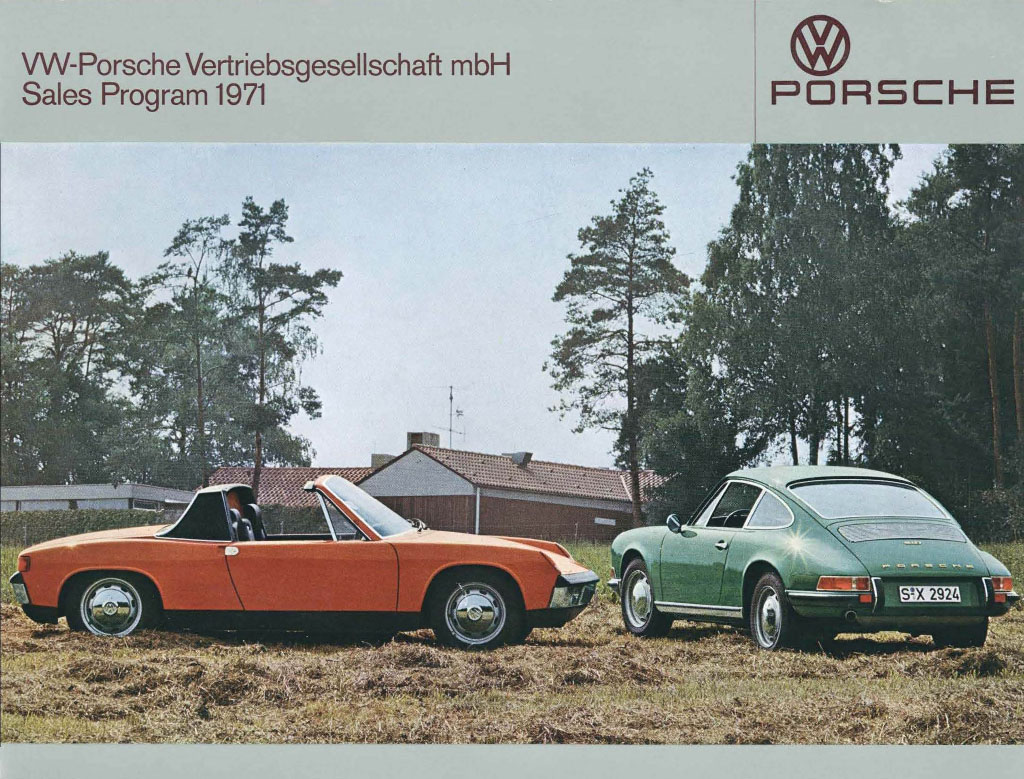
Porsche Press kit 1971 - landing page
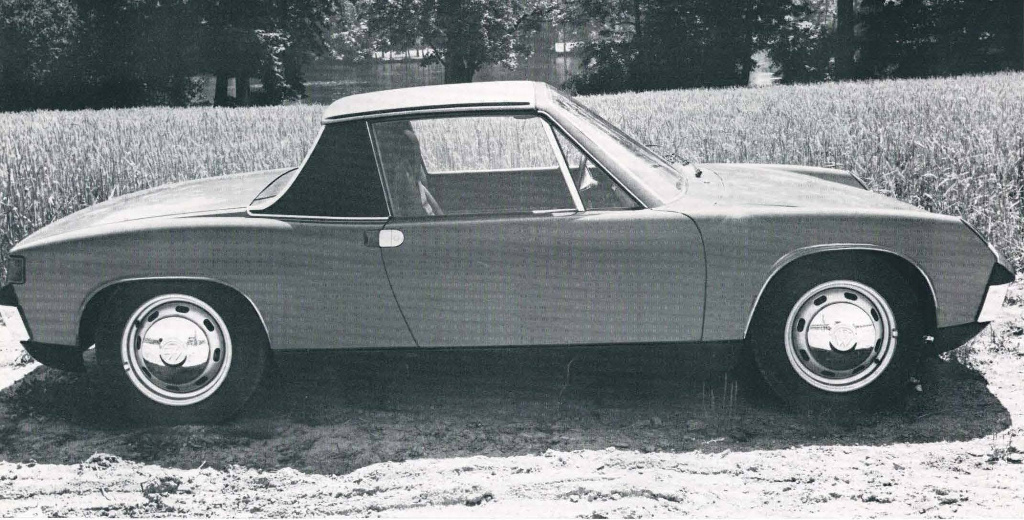
The VW-PORSCHE 914 models have been developed on the basis of a decision by Porsche and Volkswagen to build sports cars in a price category which would represent a natural complement to the existing and well-received vehicle range at the lower end of the price scale. The aim was to provide a design concept, together with craftsmanship and equipment quality, which would identify the new cars as genuine sports cars of the standard which has come to be expected from Porsche. Bearing in mind the younger purchasing group at whom this concept is primarily directed, the VW-PORSCHE 914 models were planned and laid out as pure sports cars. It can well be imagined that the competition experience gained by Porsche played a decisive part in determining the character of the new development. Thus the mid-engine principle, taken over directly from racing-car practice, is an essential feature in the design of the VW PORSCHE 914. Full-scale exploitation of the advantages of the mid-engine principle has meant sacrificing the usual emergency rear seats and storage space inside the car. However, the excellent weight distribution resulting from the central position of the center of gravity has ensured that the new design possesses quite outstanding handling and roadholding characteristics.
Seat width in the VW-PORSCHE 914 is in addition so generous that both driver and passenger have ample freedom of movement. The storage space is no longer located behind the seats but in two separate luggage compartments with a total capacity of 370 liters (13.1 cu.ft.), so that luggage space is quite comparable with that provided in the average compact sedan.
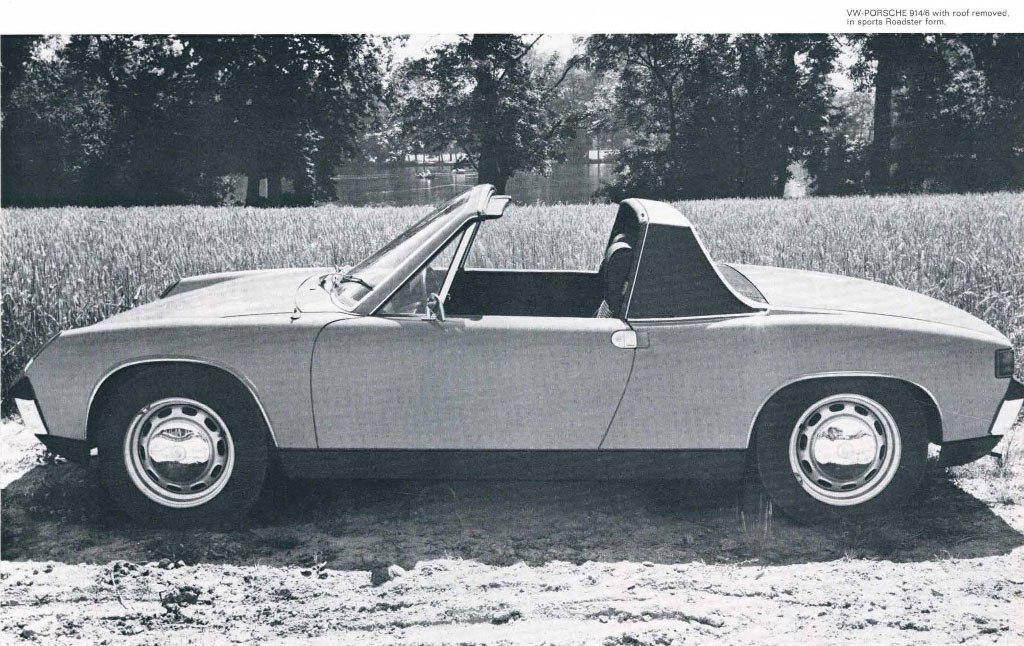
VW-PORSCHE 914 models have an all steel load-bearing two door bodyshell with integral safety roll bar and removable plastic roof. The body is welded to a floor/chassis assembly to form a single unit.
The streamlined shape of the VW-PORSCHE 914 is also smooth on the underside, and the resu lting low drag resistance enables high road speeds to be reached with moderately sized and thus economical power units.
The body is divided into several compartments by transverse bulkheads which also contribute additional rigidity. The individual sections of the body are: front luggage compartment, fuel tank cell, passenger space, engine compartment, rear luggage compartment. The front and rear sections are arranged to deform easily and absorb energy in the event of violent impact. The passenger section forms a torsionally rigid safety cell within the body structure.
The rigid plastic roof used on the 914 is light in weight, absolutely weatherproof and easily removable in a few simple movements. It is attached to the windshield frame by two locking catches, with a further two catches at the rear on the roll bar. The roof can be easily removed and stored in the rear luggage compartment. In this position only a small amount of useful luggage compartment height is lost.
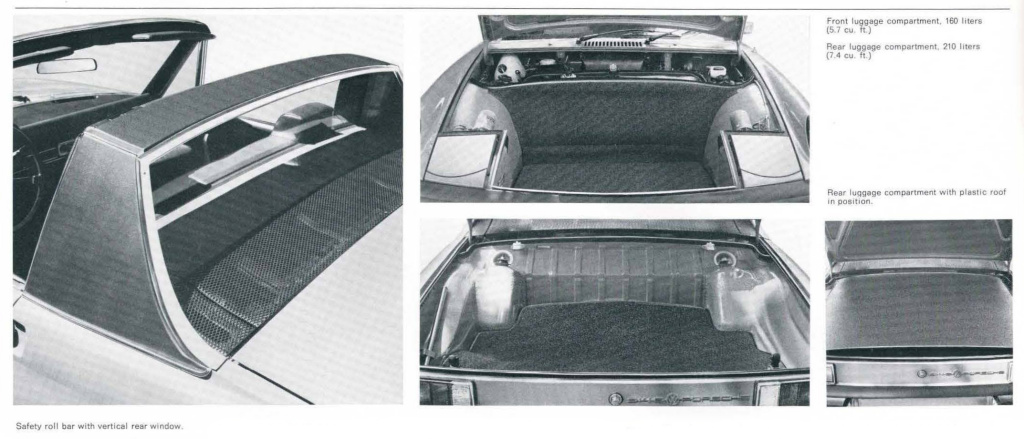
The high, domed windshield and the safety roll bar with vertical rear window ensure that the open car can be driven with a minimum of disturbing air currents and wind noise. In this way the VW-PORSCHE 914 models represent an ideal combination of the best features of a sports coupe and a convertible.
The low height of the mid engine enables the waistline to be kept low in turn. Electrically operated pop-up main headlamps form a harmonious continuation of the elegant lines. Additional halogen headlamps are installed as standard in the front bumper. Wide shaped rubber strips above the bumpers provide protection against minor damage when maneuvering and parking.
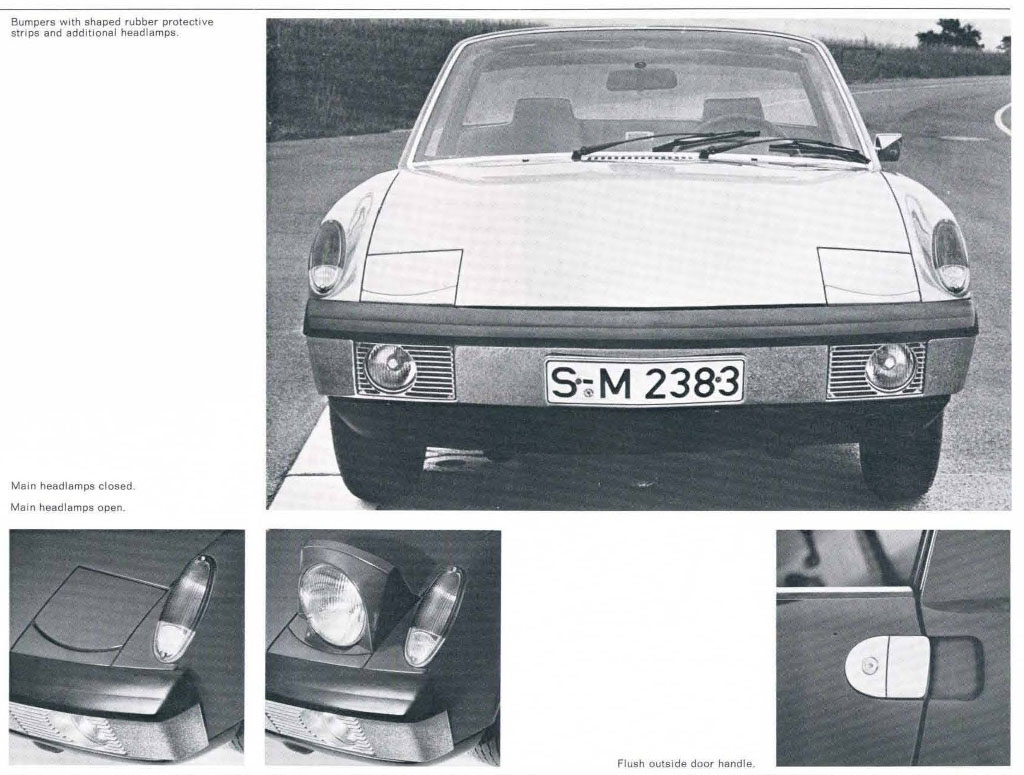
The underside of the bodyshell is undersea! protected before leaving the factory. Both doors can be locked from outside with the ignition key, and from inside by operating safety lock buttons. The driver's door can also be locked from the outside without using the key. The safety button is simply pressed and the outside door handle kept raised while the door is shut.

The VW-PORSCHE 914 is provided with the complete range of instruments needed for safe control and operation of a sports car.
Except for minor variations the same instruments are used on both VW-PORSCHE 914 and 914/6 models. The version with the more powerful engine calls for different dial calibrations on the speedometer and tachometer, and the windshield washer control, also differs in detail.
Styling and layout of the dashboard and instrument panel have been planned to meet the demand for rapid, effortless operation of all controls and a clear view of the instruments at all times without risk of confusion in critical situations.
The speedometer, with total and trip mileage odometers, and the transistorized tachometer both have large round dials with illumination of continuously variable intensity. They are located in the driver's direct field of view, and have anti-glare matt black faces.
The dial markings are matt white for easy reading and maximum visibility. A circular combined instrument dial houses warning lights for oil pressure, battery charge, handbrake (also oil temperature on 914/6) and the fuel gauge.
All knobs are recessed into the padded dashboard, and the levers made from flexible material. To prevent confusion each control is marked with a symbol indicating its function.
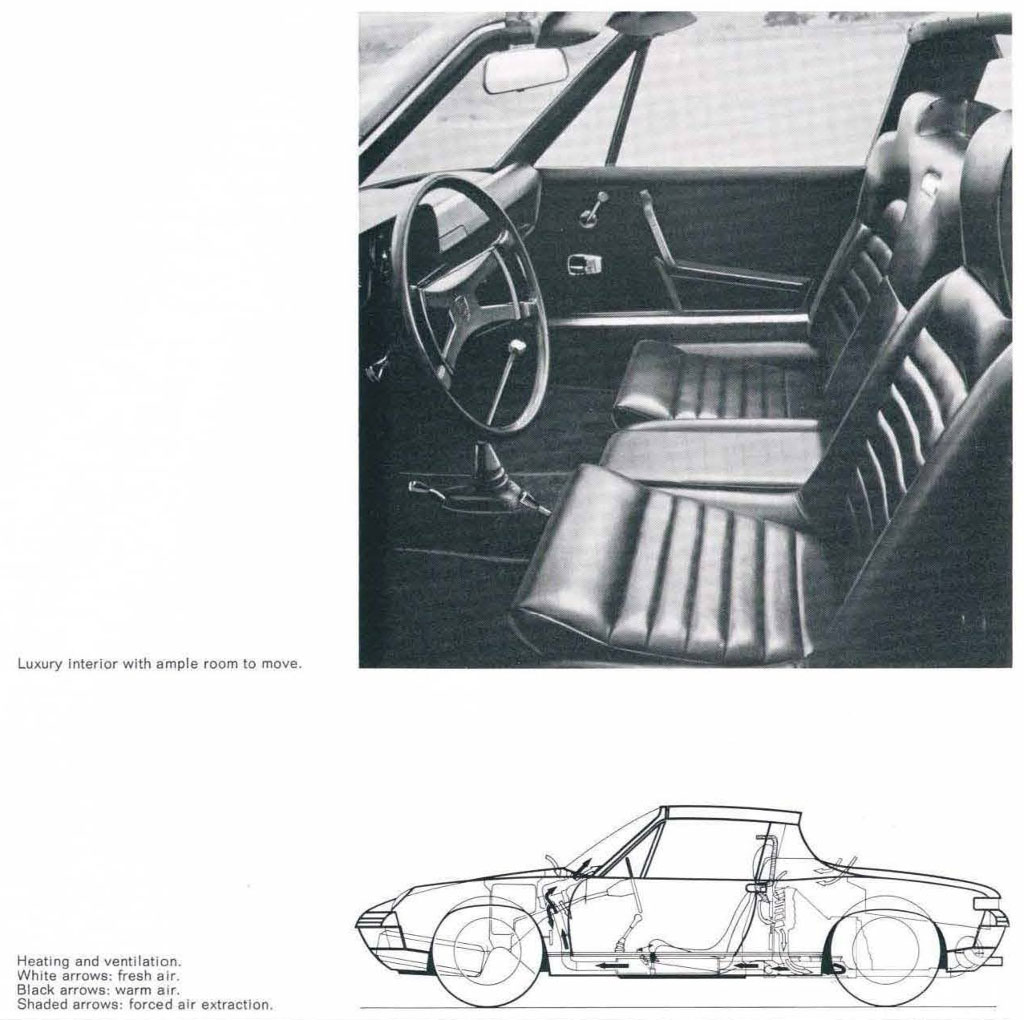
The interior of the VW-PORSCHE 914 and its equipment are designed to ensure that both the driver and passenger of this sporting vehicle can cover long distances without fatigue in maximum safety.
Anatomically correct sportscar seats complete with head restraints provide good lateral location even when cornering fast, without restricting the freedom of movement essentia I for quick reactions in an emergency. The seats can be ordered with leatherette upholstery, or corduroy fabric with leatherette edge trim. The driver's seat has forward and back adjustment, as well as 4 different height and tilt positions. It can thus accommodate drivers of widely varying height or with differing driving styles. The passenger's seat back is permanently attached to the padded rear bulkhead of the car's interior, and an adjustable toeboard is provided to ensure that passengers of various heights are firmly braced during fast driving. Needle Loom (914) or pile type (914/6) carpets matching the trim color are provided.
The VW-PORSCHE 914 models are equipped as standard with a wide range of equipment items calculated to satisfy the most demanding driver, for example three-point seat belt anchorages, combined armrests and door pockets, a passenger grab handle, padded sun visors, interior rear view mirror with anti-glare device and mounting bracket which yields on impact, cigar lighter with hand lamp socket, safety padded pull-out ashtray, matt black windshield wipers with two speeds (914) or three speeds (914/6), a pneumatic (914) or electric (914/6) windshield washer, a headlamp flasher, all-round hazard warning flashers, 2 backup lights and additional halogen headlamps in the front bumper.
Heating and ventilation are separately and continuously variable. Both heater output and fresh air supply can be directed upwards or towards the feet. Fresh air flow can be boosted by a three-speed blower.
Forced stale air extraction from the car's interior is provided, with air outlets at the base of the safety roll bar.
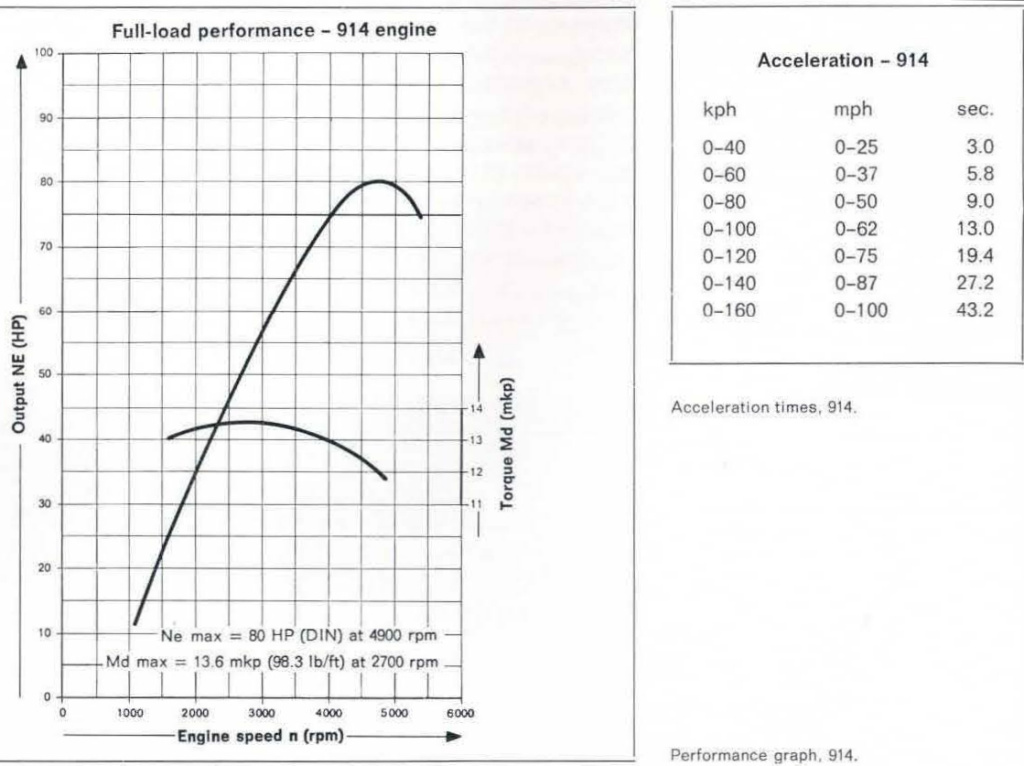
The air-cooled 1.7 liter 4-cylinder horizontally opposed engine of the VW-PORSCHE 914 develops 80 HP (DIN) at 4900 rpm. With it, the 900 kg (1985 lb) vehicle can reach a top speed of 177 kph (110 mph). It accelerates from 0 to 100 kph (0 to 62 mph) in 13 seconds, and has a power/weight ratio of 11.2 kg/HP (90 HP/ton). Since torque is in excess of 12 mkp (86 lb/ft) over the wide engine speed range from 1800 to 4800 rpm, flexibility of the 914 engine is excellent even in dense city traffic or jams. Maximum torque of 13.6 mkp (98.3 lb/ft) is developed at 2700 rpm. In addition, the standard five speed gearbox is capable of providing the correct gear ratio for any road situation.
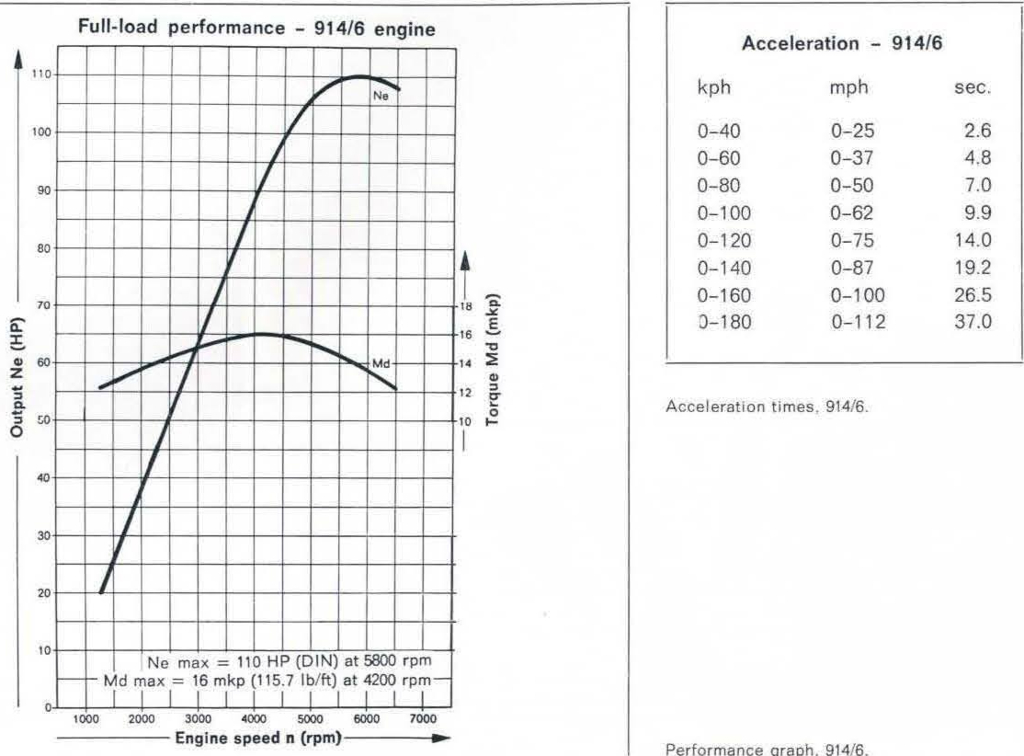
The VW-PORSCHE 914/6 6-cylinder model uses the well proven air-cooled 2 liter Porsche engine. Output is limited to 110 HP (DIN). In this form the engine is equipped with 2 triple downdraft carburetors, and propels the 940 kg (2027 lb) weight of the car at a top speed of 201 kph (125 mph). Acceleration from 0 to 100 kph (62 mph) in 9.9 seconds, and a power/weight ratio of 8.5 kg/HP (119 HP/ton) are values which emphasize the sporting character of the VW-PORSCHE 914/6.
Since torque in excess of 14 mkp (101 lb/ft) is available over the entire engine speed range from 2250 to 5750 rpm - with maximum torque of 16 mkp (115. 7 lb/ft) reached at 4200 rpm - the flexibility of the VW-PORSCHE 914/6 6-cylinder satisfies the most demanding owner. The five-speed gearbox which is standard equipment makes it possible to drive the vehicle in a highly sporting manner if so desired.
The VW-PORSCHE 914/6 is available with the option of 'Sportomatic' selective automatic transmission.
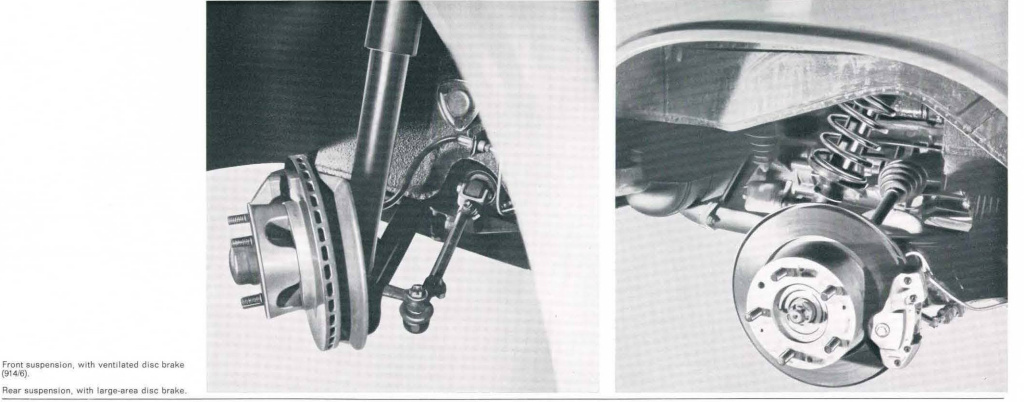
The chassis of the VW-PORSCHE 914 and 914/6 models uses independent suspension all round, the suspension characteristics being matched in each case to the available performance. The result, in conjunction with the mid-engine position, is outstanding directional stability and cornering power. Here the enormous experience gained by the House of Porsche in the design and construction of competition road vehicles can clearly be detected.
VW-PORSCHE models are equipped with the thoroughly tested space-saving front axle used on Porsche 911 cars. Despite a low hood line this enables a wide, deep luggage compartment to be incorporated at the front. The front wheels are located and suspended on transverse lower wishbones, with longitudinal torsion bars and shock absorber struts.
The rear wheels are carried on semi-trailing arms, and suspended by spring struts which combine a coil spring, a double-acting shock absorber and a Vulkollan hollow auxiliary spring. Power is transmitted to the rear wheels by 2 half shafts with double universal joints.
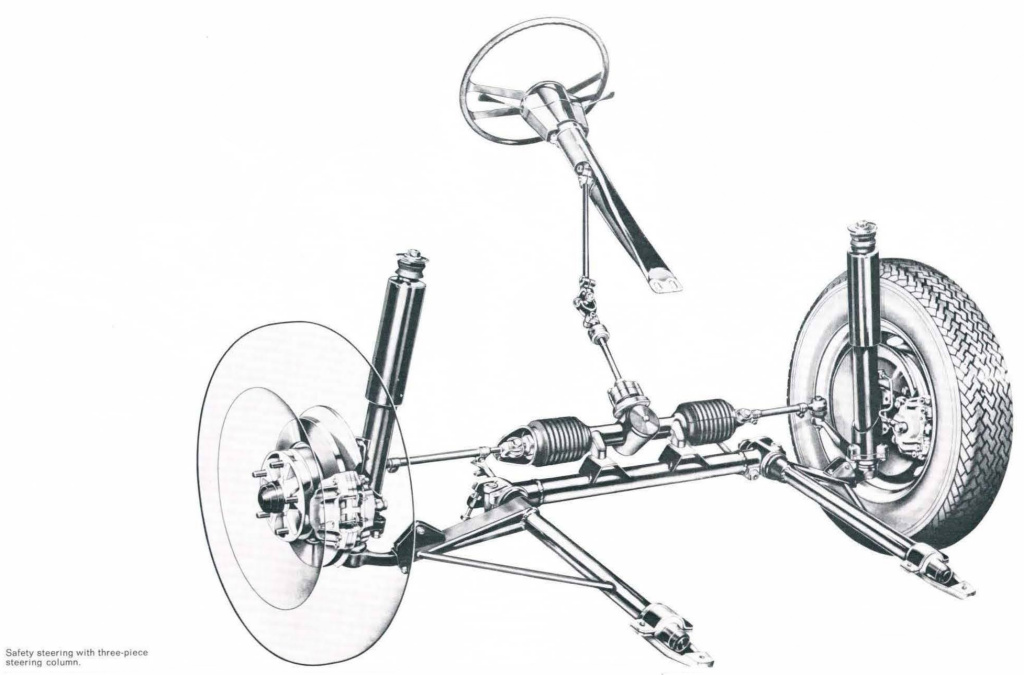
A three-piece steering column with no-maintenance universal joints and cranked center section operates the lightaction direct rack and pinion steering, which enables the vehicle to be controlled with great accuracy and precision. Since the weight of the engine is no longer supported by the front axle, power assistance is unnecessary. The steering reduction ratio is 17.8: 1, or 3 turns of the steering wheel from lock to lock. Minimum turning circle diameter is about 11 meters (36 feet).
VW-PORSCHE 914 models have self-adjusting disc brakes on all 4 wheels, and a self adjusting handbrake operating mechanically on the rear discs. The handbrake lever is beside the driver's seat and so can be reached comfortably even when wearing safety belts. The dual circuit brake system incorporates a pressure limiting valve to prevent excessive rear wheel braking and the risk of tail sliding if the brakes are applied violently. The VW PORSCHE 914/6 model has ventilated front brake discs to suit its somewhat higher road performance.
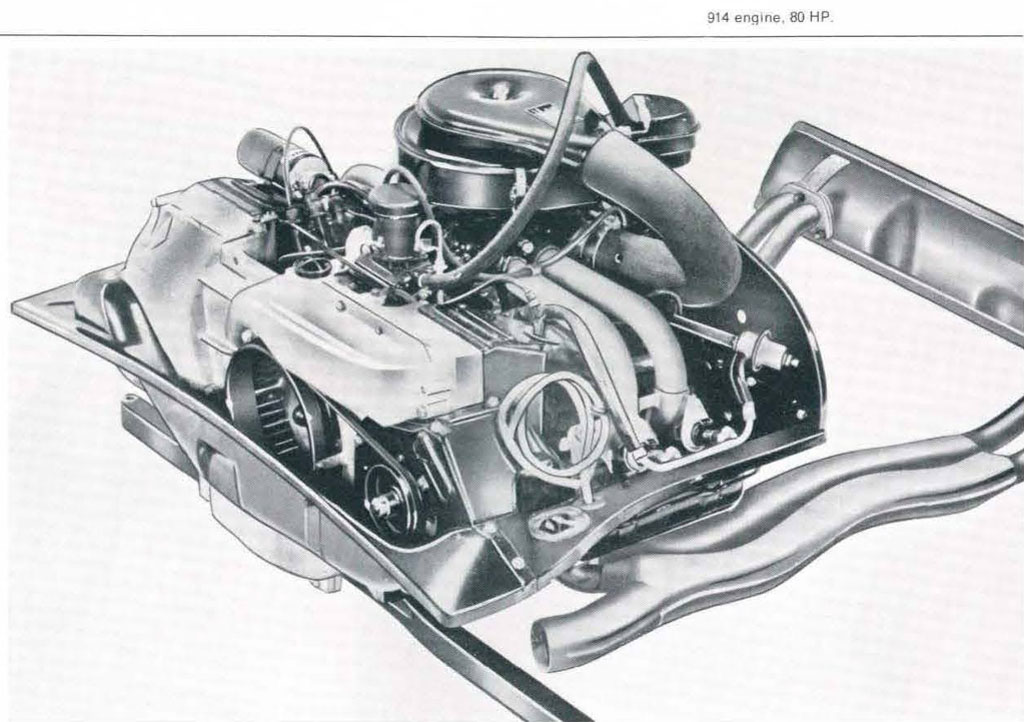
The VW-PORSCHE 914 has a 4-cylinder air-cooled horizontally opposed engine with Bosch electronically controlled fuel injection. It is installed in the mid-engine position in front of the rear axle, and combined with the clutch, fivespeed gearbox and final drive to form a single unit.
On each side, a single light alloy cylinder head is bolted onto a pair of special gray cast iron cylinder barrels. The parallel overhead valves are driven by pushrods and rockers from a central camshaft. The drive to the camshaft is by helical pinions from the engine's crankshaft. Thanks to the Horizontally opposed cylinder layout, the forged crankshaft with its four main bearings can be kept exceptionally short.
The engine is lubricated by pressure oil circulation, with a gear type pump driven from the camshaft. The oil is purified and cooled by a full flow oil filter and a plate type oil cooler mounted in the airflow from the blower. The radial cooling air blower is mounted directly on the end of the crankshaft. Airflow is controlled automatically by a thermostat. The maximum flow rate at 4600 rpm is approx. 800 liters (14.1 cu.ft) per minute.
The oversquare 1.7 liter engine develops 80 HP (DIN) at 4900 rpm and has a fuel consumption, measured in accordance with the DIN standard test method, of 8 liters per 100 km (29 US mpg, 34.8 Imp. mpg). With a bore/ stroke ratio of 90/66 mm and a mean piston speed at maximum road speed of 10. 7 m/ sec (2106 ft/min), the value is distinctly less than that achieved by the majority of sports cars.
The compression ratio of 8.2: 1 makes the 914 engine capable of burning fuel of various grades. The well-tested design features of the 914 four cylinder power unit, together with the performance data recorded here, prove it to be a robust, economical unit capable of sustaining high speeds without ill effect.
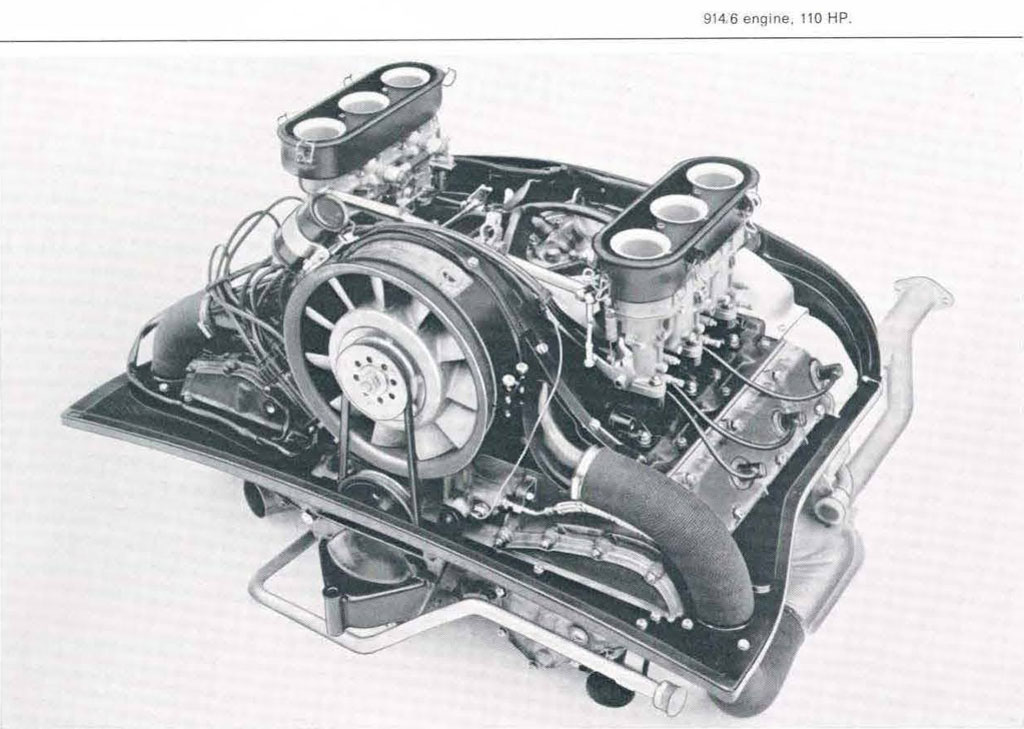
The VW-PORSCHE 914/6 has an air-cooled 6 cylinder horizontally opposed engine with 2 triple downdraft carburetors. Like the engine of the 914 model, this unit is installed in the mid-engine position in front of the rear axle and combined with the clutch, five speed gearbox and final drive to form a single unit.
The engine is the well-proven 2 liter unit developing 110 HP which was used in basically similar form to power the 1969 Porsche 911 T.
The six cylinders are arranged in two horizontally opposed banks of three on the right and left of the crankcase, and have heavily finned bolted-on light alloy heads.
The valves are arranged in an inverted V layout in the heads, and operated by rockers direct from an overhead camshaft on each cylinder bank. The camshafts are driven by chains and intermediate gear pinions from the crankshaft.
The forged crankshaft has eight main bearings. Two triple barrel downdraft carburetors supply fuel-air mixture through short intake pipes to the combustion chambers of each cylinder. Dry sump lubrication ensures an even and uninterrupted supply of oi l to all bearing surfaces even when the engine is subjected to severe cornering forces at high speed. Lubricating oil is cleaned by passing through a full flow filter, and maintained at the correct temperature by means of a thermostatically controlled oil cooler. An alternator and the axial engine cooling blower are driven by Vee belt from a crankshaft pulley.
The engine is a pronounced oversquare design, with bore/stroke ratio of 80/66 mm, so that the mean piston speed of 12.7 m/sec (2502 ft/min) is distinctly below that usually reached by sports car power units. With fuel consumption according to the DIN standard test method of only 9 liters per 100 km (26 US mpg, 31.4 Imp. mpg), and a compression ratio of 8.6: 1, the 914/6 engine is capable of notable performance without losing its reputation as a trouble free, economical unit for reliable everyday service. This engine design has become known for its reliable power output and durability.
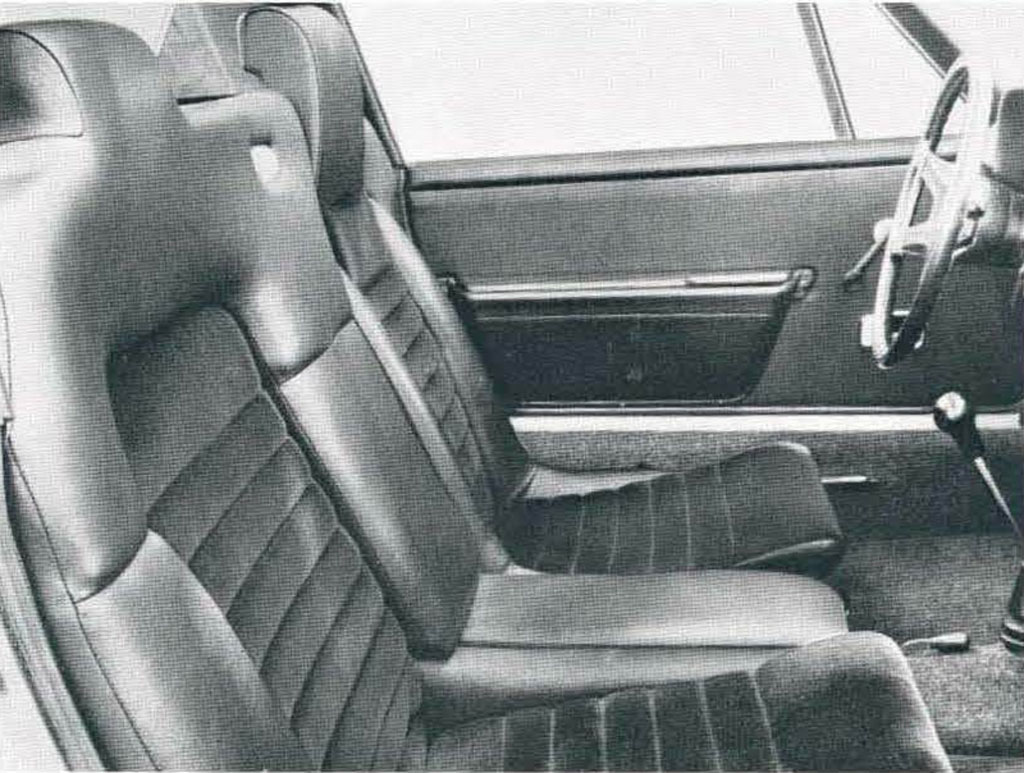
In the VW-PORSCHE 914 cars all the experience gained by both VW and PORSCHE during their safety research programs has been incorporated.
We refer to all design features ordesign-influenced characteristics which serve to prevent accidents as 'active' safety measures, whereas all design features intended to reduce the effect of accidents once they occur are described as 'passive' safety measures.
VW-PORSCHE cars have a very low center of gravity, exceptionally good weight distribution with almost exactly 50 % of the weight on the front wheels and 50% on the rear wheels, and a standard 5-speed gearbox to ensure that engine power can always be used to best effect and for maximum acceleration. These built-in reserves of road holding ability and accelerating power help to reduce the element of danger when a tricky road situation is encountered, and provide increased security by cutting down overtaking times.
Even after repeated emergency applications from high speed, the four large-diameter disc brakes continue to operate at maximum efficiency. On the VW-PORSCHE 914/6 the increased available performance has been taken into account by the provision of ventilated front brake discs.
Dual brake circuits ensure adequate braking effect even if one circuit should fail. A brake pressure limiting valve prevents overbraking at the rear, so that the tail cannot swing wide if the rear wheels lock during a violent brake application.
The excellent straight-running characteristics of the VW-PORSCHE 914 models and their light action direct steering enable the car to be steered out of the way of sudden obstacles without loss of stability.
The sports seats with built-in head restraints are anatomically correct in shape, and provide good lateral support for fast cornering without restricting the freedom of movement necessary for fast reactions in an emergency. The driver's seat has ample adjustment facilities to suit any driving position and thus prevent premature fatigue on long journeys. Draft-free forced stale air extraction from the car's interior is another factor helping to reduce driver fatigue by continuously changing the air supply.
Well placed controls and switches, clearly marked with symbols indicating their functions, clearly visible, non-glare instrument dials and halogen additional headlamps all make their contribution to safe, relaxed driving. The two-speed (914) or three-speed (914/6) windshield wipers with their matt black wiper arms and the combined wiper-washer unit ensure clear vision at all times and thus adequate information concerning the movements of other traffic and the state of the road.

VW-PORSCHE 914 models include a host of measures designed to reduce the effect of accidents - contributions to passive safety. The safety windshield (914) and the laminated windshield (914/6), the three piece cranked steering column, the steering wheel with recessed boss and large-area padded horn push are all planned to give the driver and passenger maximum possible protection in the event of an accident.
The dashboard is padded at its upper and lower edges, and all switch knobs are either recessed or else made from resilient material. This will largely prevent minor injury in the event of a violent collision. The fuel tank is located in an impact-proof zone behind the front luggage compartment and the spare wheel, and is scarcely likely to suffer damage in an accident.
The front and rear sections of the all-steel load bearing bodyshell are designed to deform easily and absorb impact energy, while the passenger compartment forms a torsionally rigid safety cell inside the main bodyshell. The safety roll bar which forms an integral part of the body spans the rear of the passenger compartment even when the roof is removed, and thus ensures the occupants of protection at all times.
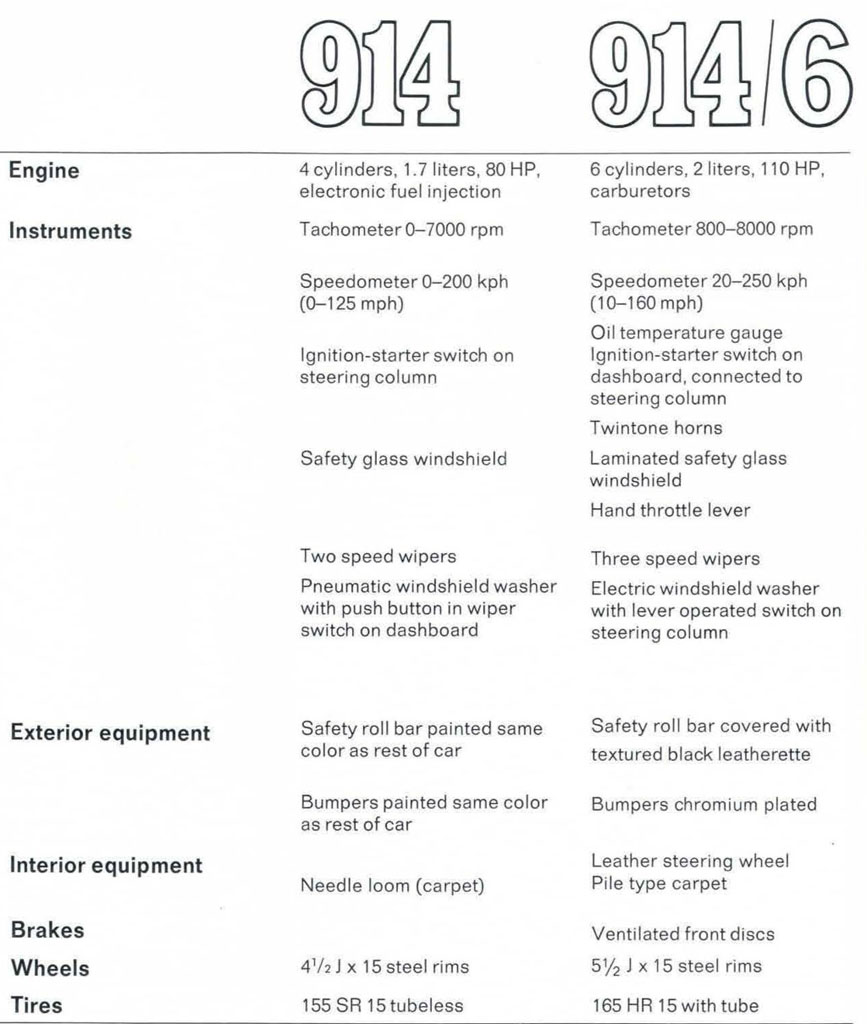
OPTIONAL 'S' PACK for 914
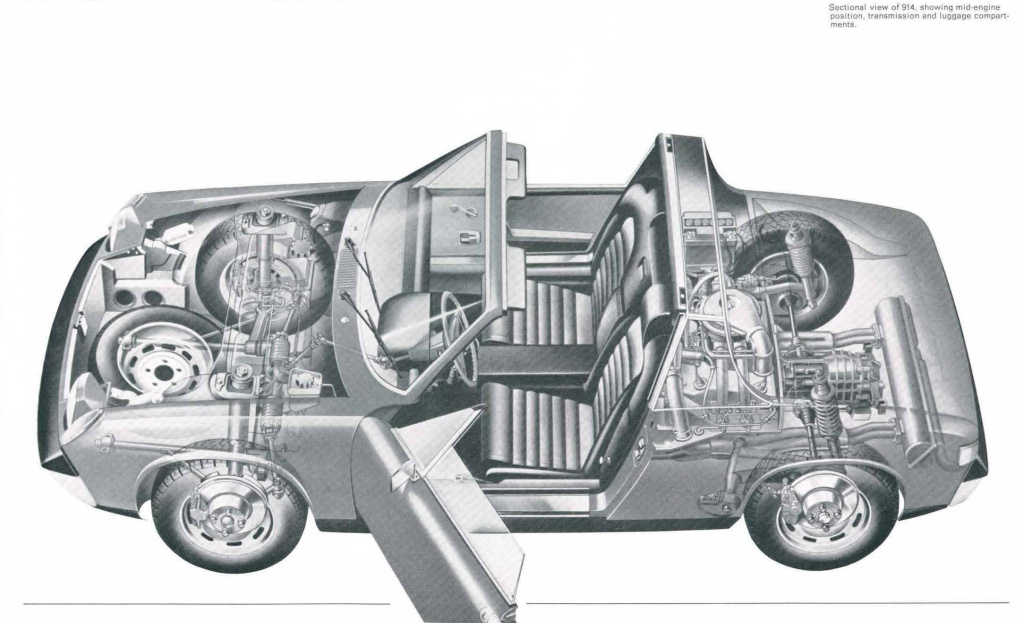
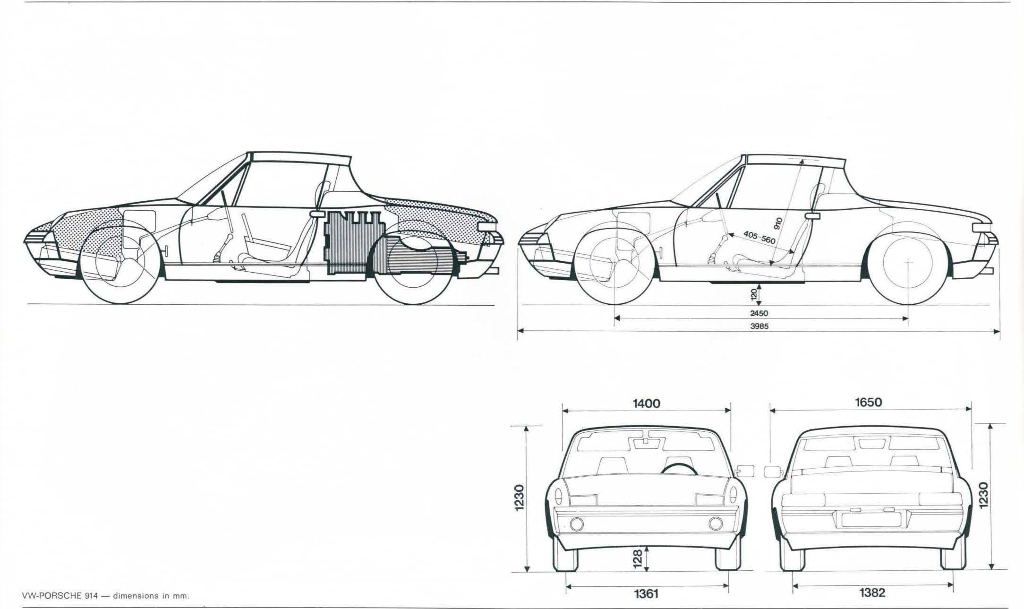
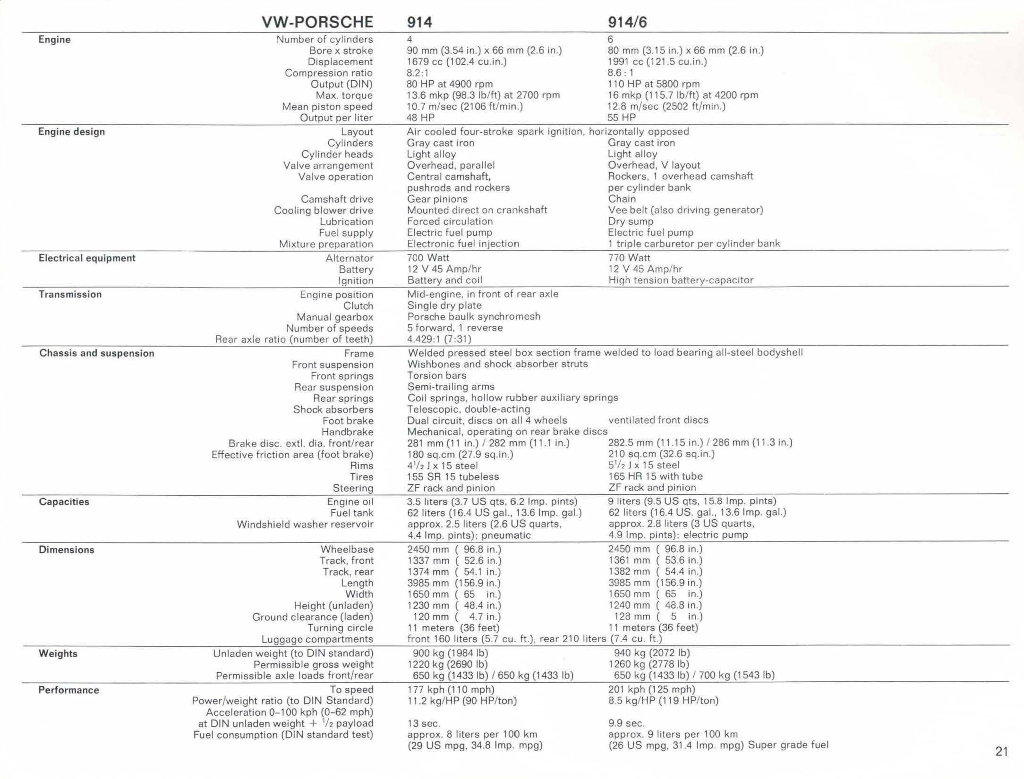

Porsche Press kit 1971 - landing page
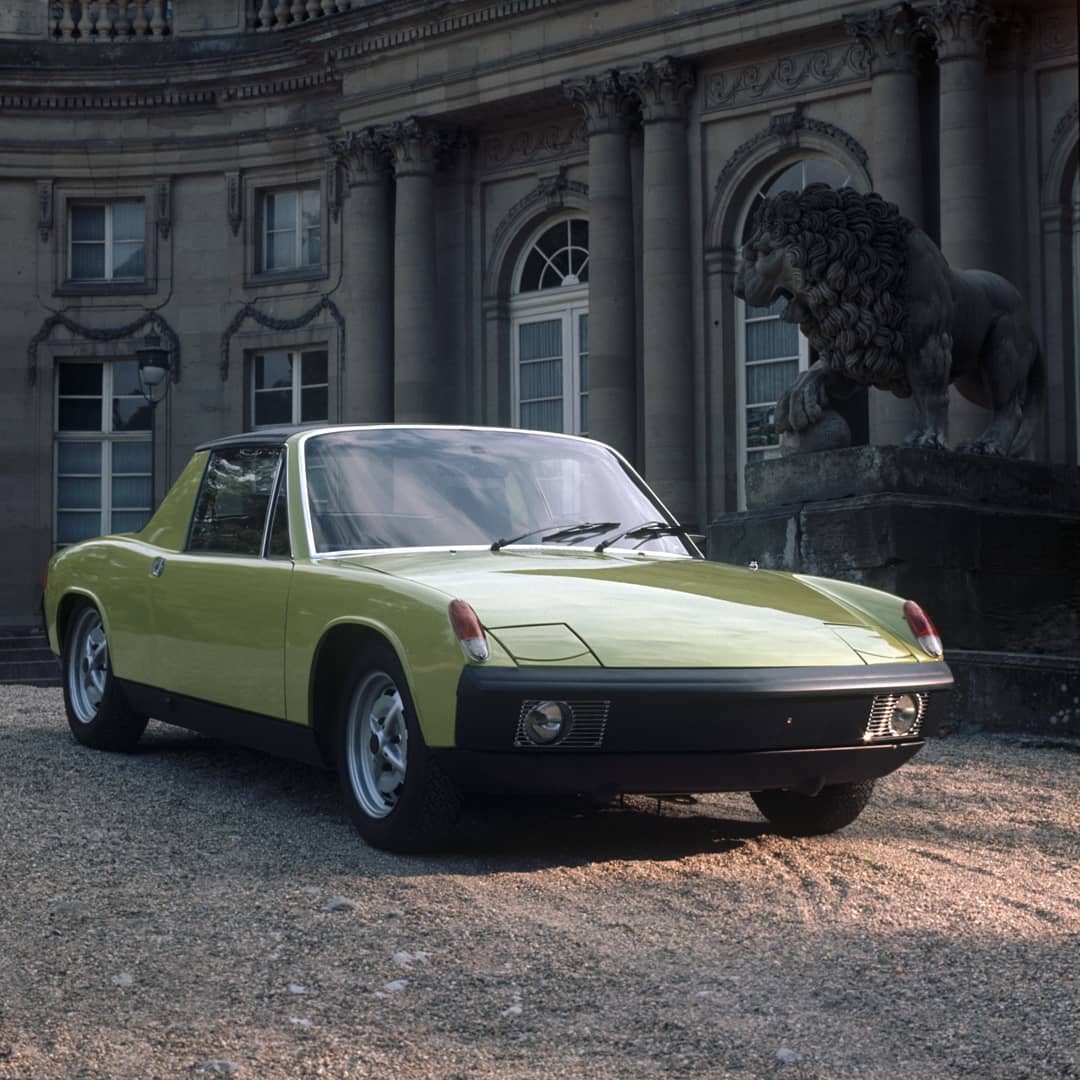
PORSCHE PRESS KIT 1970 - 914 AND 914/6

Porsche Press kit

Porsche Literature

Our Porsche Cars